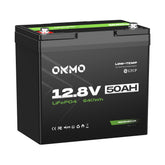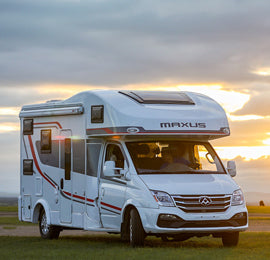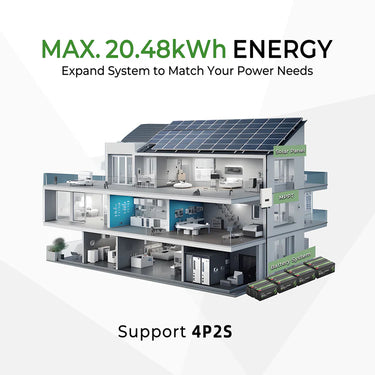12 Volt Battery for Riding Lawn Mower Market Analysis & Buying Guide
 Across America's vast lawns, the riding lawn mower is an indispensable tool for homeowners and professional landscapers. Powering these "lawn tractors" is often a seemingly unassuming 12V battery. This article delves into the current state of the US lawn mower battery market, details the mainstream 12V battery types, and reveals the key logic behind choosing the right one.
Across America's vast lawns, the riding lawn mower is an indispensable tool for homeowners and professional landscapers. Powering these "lawn tractors" is often a seemingly unassuming 12V battery. This article delves into the current state of the US lawn mower battery market, details the mainstream 12V battery types, and reveals the key logic behind choosing the right one.
Part 1: Current US Lawn Mower Battery Market: Lead-Acid Dominates, Lithium Emerges
-
The Absolute Reign of Lead-Acid Batteries:
-
Mature Technology, Low Cost: With over a century of history, lead-acid batteries benefit from mature manufacturing and relatively accessible raw materials, making them the most cost-effective choice. A standard 12V lead-acid mower battery typically costs between $40 - $120 (depending on brand, capacity, type), significantly less than lithium batteries.
-
Widespread Compatibility: The electrical systems (starter motor, lighting, charging system) of the vast majority of riding mowers are designed around the 12V lead-acid battery, making replacement and maintenance extremely convenient.
-
Established Recycling System: The US has a mature lead-acid battery recycling network (retailers often accept old batteries for a core charge refund), achieving very high recycling rates and complying with environmental regulations.
-
-
The Rise and Challenges of Lithium Batteries:
-
Significant Advantages: Much lighter weight (50%+ reduction), longer cycle life (up to 3-5 times lead-acid), lower self-discharge rate (longer storage), faster charging, maintenance-free, and better cold-cranking performance (especially in cold climates).
-
Core Pain Point: High Price: A comparable 12V lithium battery typically costs 3-5 times more than lead-acid ($150 - $400+), presenting the biggest barrier to widespread adoption.
-
Market Position: Currently appeals mainly to high-end users or professional landscaping companies seeking ultimate convenience and willing to invest for long-term value. Primarily sold as "upgrade replacements," while OEM installations still predominantly use lead-acid.
-
-
Market Trend: Lead-acid batteries will remain absolutely dominant for the next 5-10 years, especially in the economy and mid-range riding mower markets. Lithium battery share will grow steadily, but significant price reduction is key for broader adoption. Market demand is increasing for "more durable, lighter, and more eco-friendly" batteries.
 Part 2: Detailed Look at Main 12V Battery Types for Riding Mowers
Part 2: Detailed Look at Main 12V Battery Types for Riding Mowers
Primarily two classes of lead-acid batteries, with lithium as an emerging option:
-
Flooded (Wet Cell) Lead-Acid Batteries:
-
Structure: The most traditional form, featuring removable caps for accessing the liquid sulfuric acid electrolyte.
-
Advantages:
-
Lowest Price: Most cost-effective.
-
Serviceability: Electrolyte levels can be topped up with distilled water if low.
-
-
Disadvantages:
-
High Maintenance Required: Electrolyte levels must be checked regularly (typically every 1-3 months), ensuring plates are submerged. Low levels cause permanent damage.
-
Prone to Leakage: Acid can spill if tipped or inverted, corroding equipment or harming skin (gloves required). Must be installed upright.
-
Higher Self-Discharge Rate: Prone to sulfation and damage if left discharged during long storage (e.g., winter); requires disconnecting the negative terminal or using a maintainer charger.
-
Gas Emission: Emits small amounts of hydrogen and oxygen (flammable mix) during charging; ventilation is essential.
-
-
Best For: Extremely budget-conscious users willing and able to perform regular maintenance. Common in economy models at large discount retailers (e.g., Walmart).
-
-
Valve-Regulated Lead-Acid (VRLA) Batteries:
-
Sealed & Maintenance-Free: This is the absolute leader in OEM installations and the aftermarket for US riding mowers. Two main technologies:
-
AGM (Absorbent Glass Mat): Electrolyte is absorbed by a fiberglass mat; no free liquid.
-
Gel: Electrolyte is gelled (less common than AGM in mower applications).
-
-
Advantages:
-
Truly Maintenance-Free: No need to check or add electrolyte throughout its lifespan. Sealed design.
-
Leak-Proof & Spill-Proof: Can be mounted in any orientation (though usually upright), no acid leakage risk.
-
Lower Self-Discharge Rate: Discharges 3-5 times slower than flooded types when stored; less prone to dying during storage.
-
Better Vibration Resistance: AGM structure withstands the bumps and jolts of mowing better.
-
Superior High-Rate Discharge Performance: Delivers strong Cold Cranking Amps (CCA).
-
Longer Expected Lifespan: Typically 20-50% longer than comparable flooded batteries.
-
-
Disadvantages:
-
Higher Price: Costs about 20%-50% more than flooded types.
-
Slightly Finer Charging Requirements: Best charged with a smart charger featuring an "AGM mode"; overcharging can cause damage (though modern mower charging systems are usually compatible).
-
-
Best For: The recommended choice for the vast majority of users. Offers the best balance of performance, convenience, and cost. Numerous brands available (e.g., Interstate, DieHard, MotoMaster, Universal Power Group, Duracell).
-
-
-
Structure: Primarily use Lithium Iron Phosphate (LiFePO4) chemistry, usually with a built-in Battery Management System (BMS).
-
Advantages: (As previously mentioned) Extremely light, ultra-long lifespan, very low self-discharge, fast charging, maintenance-free, good performance across a wide temperature range.
-
Disadvantages: High price is the main hurdle. Some cheap products have inadequate BMS protection or poor-quality cells, posing safety risks. Must ensure physical dimensions and terminal types match the mower.
-
Best For: Users with ample budget seeking extreme lightweight (easy to remove for charging/storage), long-term value, or living in areas with harsh winters. Brands like Ampere Time, Weize, ExpertPower offer compatible models.
-

 Part 3: Why Choose a 12V Battery? Core Logic Explained
Part 3: Why Choose a 12V Battery? Core Logic Explained
-
Industry Standard & System Compatibility:
-
The engine starter motor, alternator, lighting system, ignition system (on some older models), and safety switch circuits of riding mowers are all designed for 12V DC power. Using a 12V battery is the fundamental requirement to ensure the entire electrical system functions correctly and avoids equipment damage.
-
-
Starting Power Demand:
-
Riding mowers typically have single or multi-cylinder small gasoline engines (e.g., Briggs & Stratton, Kohler). While smaller than car engines, they require significant starting torque. 12V lead-acid batteries (especially AGM) provide sufficient Cold Cranking Amps (CCA) (typically in the 200-500 CCA range) to deliver the high burst of current needed to crank the starter motor and turn the engine over. Lithium batteries often offer superior CCA performance in cold temperatures.
-
-
Cost-Effectiveness & Maturity:
-
For residential riding mowers, used limited hours per year (tens to a few hundred hours), and where the equipment itself isn't extremely high-value, mature, reliable, and inexpensive 12V lead-acid batteries (especially AGM) offer the best Total Cost of Ownership (TCO). The high initial investment of lithium batteries makes their ultra-long lifespan advantage harder to realize as a quick return in low-usage home scenarios.
-
-
Availability & Convenience:
-
12V lead-acid batteries (especially Group U1 size AGM) are ubiquitous in the US. Available everywhere from large home improvement stores (Home Depot, Lowe's), auto parts chains (AutoZone, Advance Auto Parts, O'Reilly), big-box retailers (Walmart, Costco), to specialized mower dealers. Replacement is extremely convenient. Lithium battery purchasing channels are comparatively narrower.
-
-
Charging Convenience:
-
The small alternator on the riding mower charges the 12V battery while running, requiring no extra user effort. During winter storage, a standard 12V smart charger (many even support AGM mode) easily maintains the battery. Lithium batteries are usually compatible with 12V charging systems but perform best and last longest when charged with a dedicated lithium charger.
-
 Part 4: Buying Advice: Matching the Best "Heart" for Your Steed
Part 4: Buying Advice: Matching the Best "Heart" for Your Steed
-
AGM is the Top Choice: For the vast majority of users, a maintenance-free 12V AGM battery is the optimal balance. Hassle-free, reliable, sufficiently powerful, and reasonably priced. Look for reputable brands and sufficient CCA (check your mower manual or old battery specs).
-
Confirm Size & Terminals: The most common riding mower battery size is Group U1 (some use Group 26, 35, etc.). Ensure length, width, height, and terminal post type (usually SAE posts or automotive terminals/L-ports) match the battery box.
-
Focus on CCA Value: Cold Cranking Amps (CCA) is the critical performance metric. Choose a battery with CCA equal to or higher than the OEM recommendation. Users in cold climates should opt for higher CCA or consider lithium.
-
Capacity (Ah) is Secondary: For mowers primarily needing to start the engine, CCA is more important than Capacity (Ah). Ah affects how long lights or other accessories work with the engine off, but this is usually not the main limitation.
-
Lithium: Upgrade if Needed: If budget allows, you prioritize lightweight (especially needing frequent removal for charging/storage), or the equipment sees very high use/you expect ultra-long life, a high-quality 12V lithium battery is a worthwhile upgrade option. Choose reputable brands with robust built-in BMS.
-
Avoid Flooded Types: Not recommended unless on an extreme budget and committed to strict maintenance. The hassle and potential risks aren't worth the minor cost savings.
-
Recycle Your Old Battery: Always bring your old battery when buying a new one. Retailers usually charge a core deposit; returning the old battery gets this refunded (typically $10-$20) and, more importantly, supports environmental recycling.
 Conclusion
Conclusion
In the US lawn mower market, the 12V battery remains the essential powerhouse of riding mowers, a status likely to endure for the foreseeable future. Lead-acid batteries, particularly maintenance-free AGM technology, dominate the mainstream market through their unparalleled cost-effectiveness, reliability, and system compatibility. While lithium batteries showcase compelling advantages, their high price remains a significant barrier to mass adoption. For consumers, understanding the characteristics of different battery types and selecting a 12V AGM battery with matching CCA and correct physical size – based on budget, usage patterns, and maintenance willingness – represents the most cost-effective and practical choice today. When you press the starter button and hear the engine roar to life, this small 12V battery has silently completed its mission, the unsung hero conquering your lawn.








